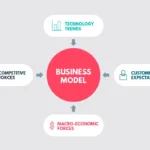SUSTAINING DIGITAL TRANSFORMATION
Part 3 of 3: Business & Digital Transformation (Read Part 1 and Part 2)
Digital transformation begins with weaving a consistent thread of digital modification across your organization’s corporate fabric. Keeping that momentum going, however, is easier said than done. According to Altimeter’s 2016 State of Digital Transformation, only 29% of the companies have established a multi-year roadmap for transformation — a telling example of how sustaining digital transformation efforts beyond its initial glory days remains a puzzling challenge for many organizations.

While a digital-first mindset can give brands a competitive advantage over their non-digital counterparts, if ‘being digital’ is not part of your DNA, transformation initiatives will often stall out. So what can companies do to avoid this reality?
PRIORITIZE PEOPLE AND PROCESSES TO BUILD CULTURE

The most important resources that any organization can possess are its people. The workforce. That’s because human capital creates value — value that wraps itself around your product or service and differentiates your business in the eyes of your customers.
As this value is created, your organization develops ‘processes’ that breed efficiency and reliability. To add operational scale, businesses will optimize these processes, or they’ll decide to bring in more skilled employees, or they’ll introduce new technology platforms. This balanced combination of people, processes, and platforms is what allows brands to grow and profit. But as digital transformation initiatives gain traction, far too often organizations will focus their efforts solely on upgrading platforms. The side effect? People and processes are ignored.
Digital transformation, of course, is not just centered around technology — and to sustain its momentum, businesses must invest equal time and resources towards their people and process to establish a digital-first culture.
Just because a company launched in the past 10–15 years, when ‘digital-first’ originally reared its head, does not indicate that organization is necessarily ‘being digital’. Instead, it’s about the mindset and skills that are required to adapt quickly during the transformation journey.
A company’s leadership, especially the CEO, needs to lay out the vision and clearly communicate the purpose and goals. Creating the north star for the company and rallying the troops behind a compelling vision remains the top responsibility for Chief Executives. However, most CEOs are not completely prepared for this transformation challenge. They understand the industry shifts and immediate need to evolve their company’s business model; however, they have not been trained to handle these massive changes during their career. The majority of CEOs have enjoyed stable environments and haven’t necessarily face major macro-economic shifts nor emerging competitive entrants. Couple that with constantly evolving customer expectations and technological advances, the C-level is not able to wrap their heads around what’s necessary to innovate at the pace that’s required to compete.
CREATE A TRANSFORMATION CENTER OF EXCELLENCE

One way that a company’s leadership team can steward their digital transformation initiatives is to enact a Transformation Center of Excellence (CoE) or digital steering committees. 53% of companies have informal digital transformation steering committees; while 40% have more formalized committees. Besides creating a formal infrastructure to provide accountability on Digital Transformation initiatives, the primary tasks of the Transformation CoE should include:

INSTALL CHANGE MANAGEMENT

There are two universal truths throughout any business: people don’t like change and old habits die hard. In order to eliminate traditional mindsets and legacy processes that work against your Transformation CoE, companies must find a way to motivate their employees to embrace a digital-first approach.
In 2003, McKinsey published, “The Psychology of Change Management”, a time-tested article that outlines the four building blocks that help organizations establish change management and re-shape employee behavior. Those are:

To further propel Digital Transformation adoption, companies need to modify the ways they incentivize their employees. You can’t expect transformative outcome without offering an equally transformative input. By creating a compensation structure that aligns employee actions with your organizational ambitions, you can ensure your Transformation CoE is embraced from the start.
PROCESS AND EXECUTION

Execution is where the rubber truly meets the road. This is where you either produce results, or start losing faith. Transformation CoE plays a crucial role throughout the execution phase to keep the agenda moving forward and maintaining confidence. Questioning your existing processes and optimizing them continuously should be top of mind for every manager during this phase.
Business Process Reengineering is the practice of redesigning the way work is done to better support an organization’s goals and objectives. The ‘this is not how things are done here’ mentality needs to be axed immediately. Or, ‘our unit is not responsible for this action, and now we are stuck’ has no place in a company’s new digital culture. Brands like Adobe and Intel embraced the change around them, not only evolving their product offerings from traditional, desktop-based softwares and hardwares to SAAS-based solutions, but also creating material changes to their existing business processes when it came to product development, sales and marketing, go-to-market strategies, and customer support.
The most difficult aspect of digital transformation is sustaining its momentum. To maintain inertia, companies must embed a digital culture, empower a change agent to create a Center of Excellence and lead the cause, establish a measurement framework, and deploy business management systems to sustain these efforts over a long haul.
It’s important to keep Digital Transformation from being just a flash in the pan. Because once it’s in motion, the only direction to go is forward.
Note: Originally, this article was published in Spring of 2017 on R2i website.



